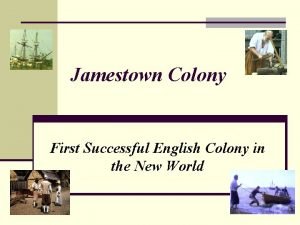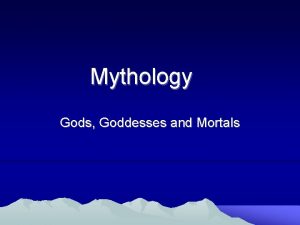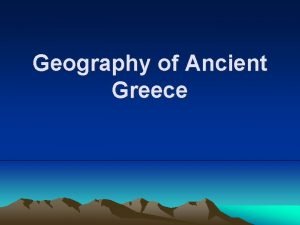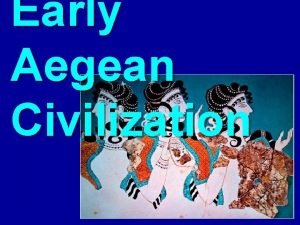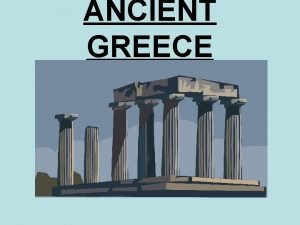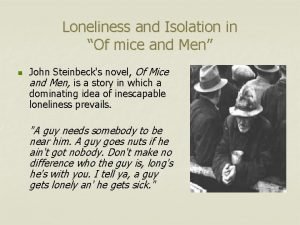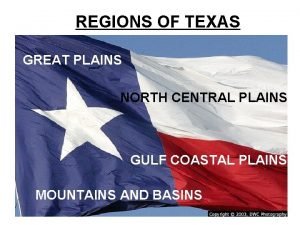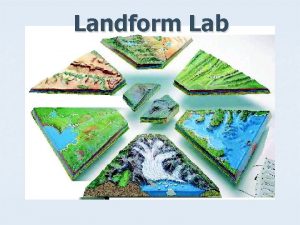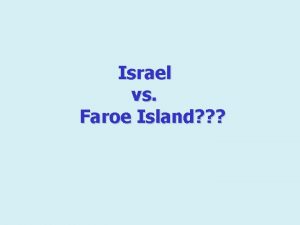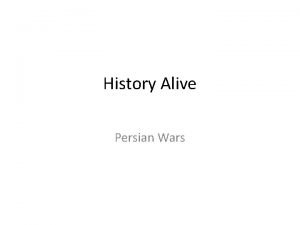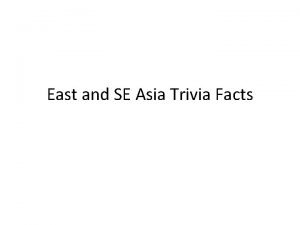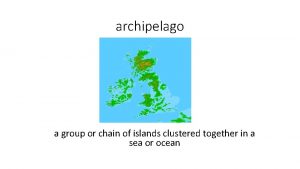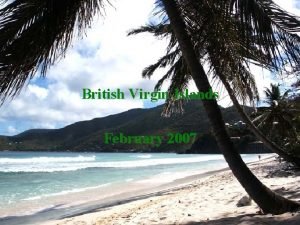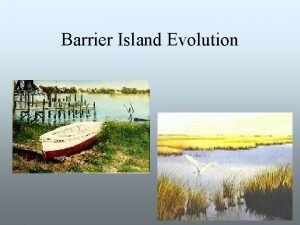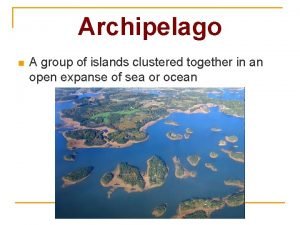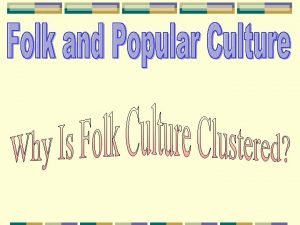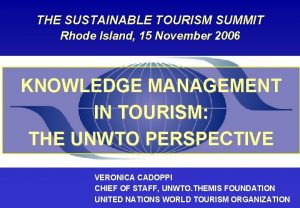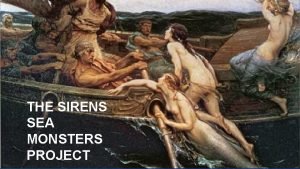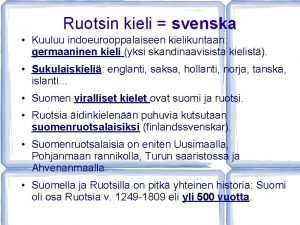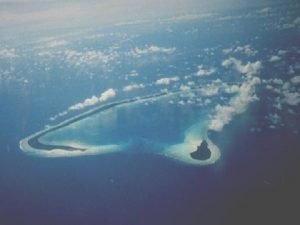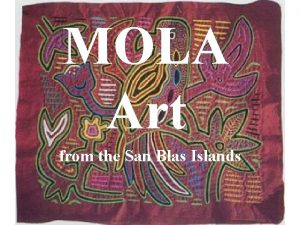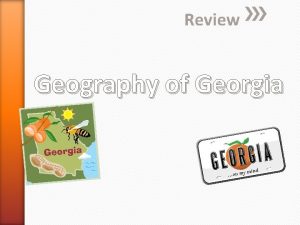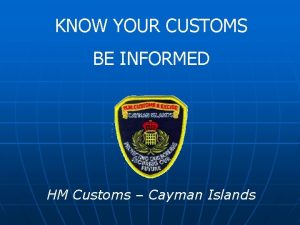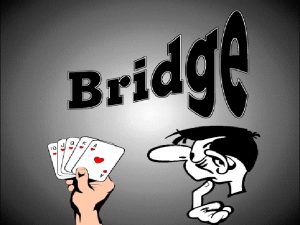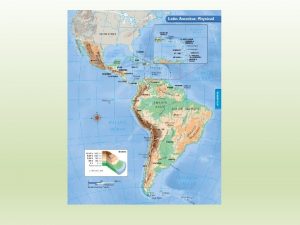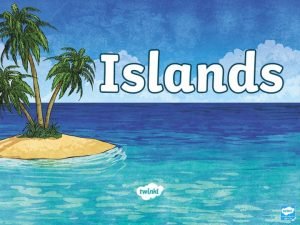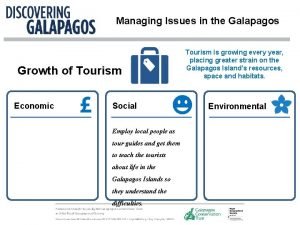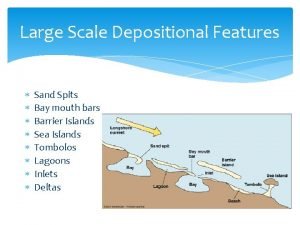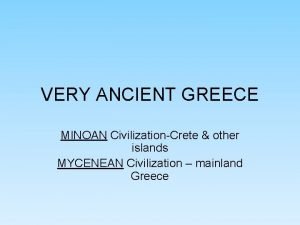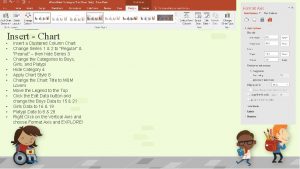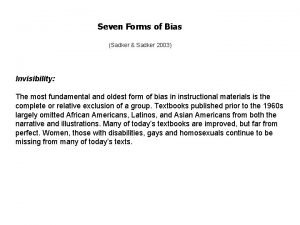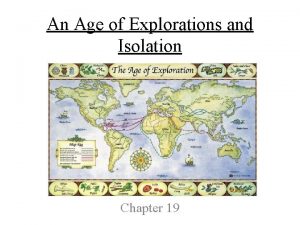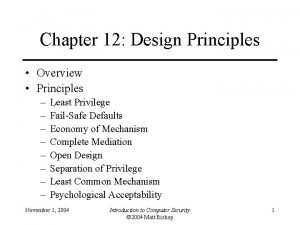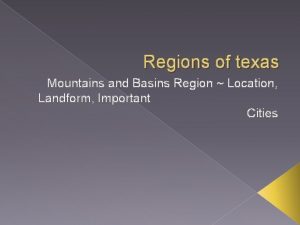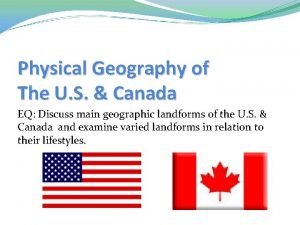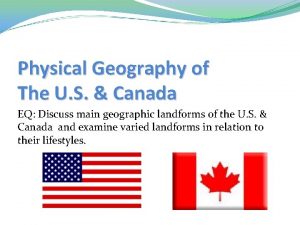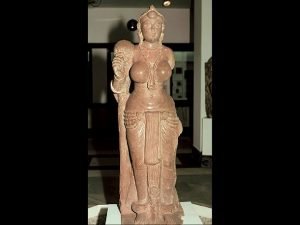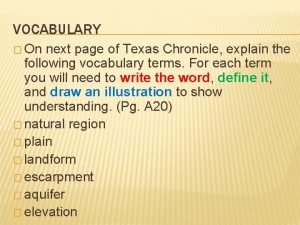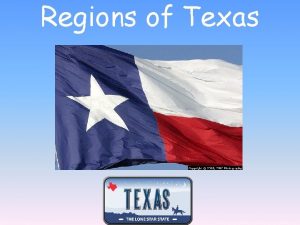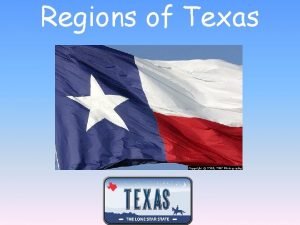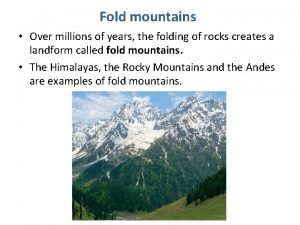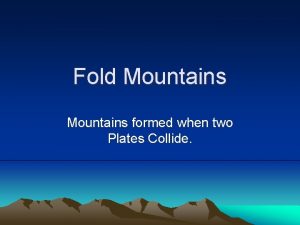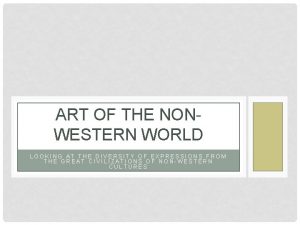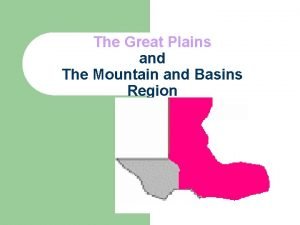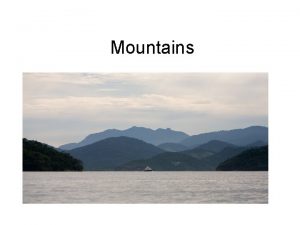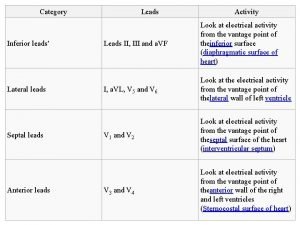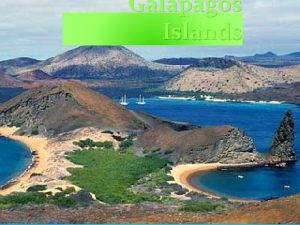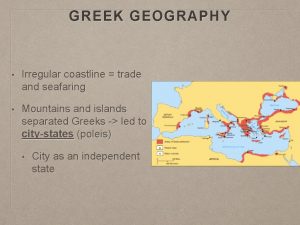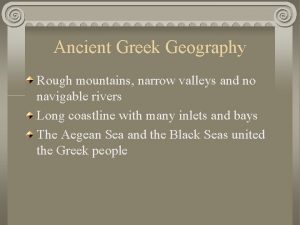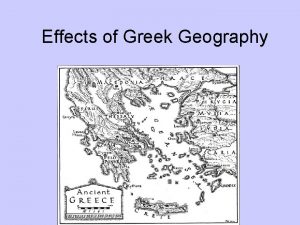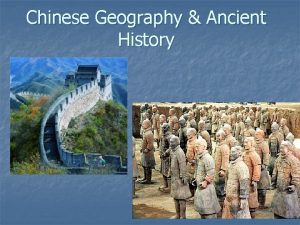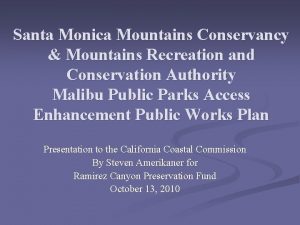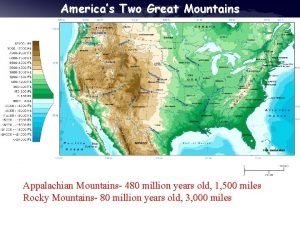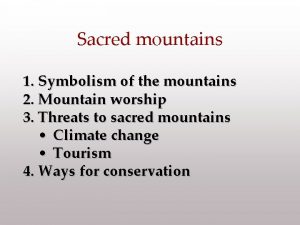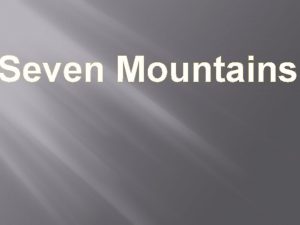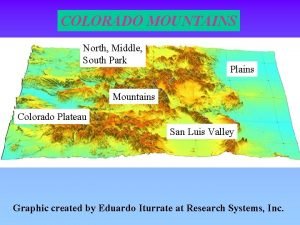Greek Geography Mountains and islands created isolation Leads
























































![Zarathustra [Zoroaster], 6 c BCE: Good Thoughts, Good Deed, Good Words “Tree of Life” Zarathustra [Zoroaster], 6 c BCE: Good Thoughts, Good Deed, Good Words “Tree of Life”](https://slidetodoc.com/presentation_image/84894040546e2ec6d31b53dde2f4cd29/image-57.jpg)


























- Slides: 83



Greek Geography • Mountains and islands created isolation • Leads to independent Greek citystates • Greek Mainland=peninsula= body of land with water on 3 sides • Mild weather • Blessed with lots of good harbors • Mountains led to isolation led to political disunity • Most plentiful natural resources =trees • Built ships from trees

Minoan civilization arose on the island of Crete.

Greek Geography continued • Made living from sea=fished, sailed, traded • Rocky soil= not ideal for planting • Some places could grow wheat, barley, olives, and grapes • Also herded sheep and goats • Greece located east of Ionian Sea • North of Mediterranean Sea • West of Aegean Sea

Minoans + Mycenaeans = The Greeks Origins of the Greeks: Minoans & Mycenaeans 2800 B. C. E. - 1500 B. C. E.

The Minoans 2000 - 1375

Minoans (2800 -1400 BCE) http: //ccwf. cc. utexas. edu/~tjmoore/Myth 3 web/05 atheseusmincan. jpg. • Archaeologists Arthur Evans discovered ruins of Minoans • Minoans Lived on island of Crete • Existed during Egypt’s Old Kingdom • Government: Priestkings • Religion: Polytheists • Cities NOT surrounded by walls

• Ship Builders & Traders (main economy) • Built ships from oak and cedar • Farming • Fishing • Traded with Egypt and Syria • Overpowered by Mycenaeans by 1400 BCE • Or great earthquake destroyed them

Minoan Art Sculptures, Pottery, and Frescoes= made out of plaster with paintings on it.

Minoans created and traded pottery, leather, bronze armor, and metal jewelry. They also enjoyed sports such as boxing and bull leaping. http: //ccwf. cc. utexas. edu/~tjmoore/Myth 3 web/05 atheseusmincan. jpg

Minoan Fresco at the Palace of Knossos http: //ccwf. cc. utexas. edu/~tjmoore/myth. html.

Minoan fresco: Prince of Knossos http: //www. graeco-roman. com/items/G 4310. htm

Frescoes examples: dolphins trade bull


Bull Leaping • Bull leaping or bull fighting was both a sport and a religious ceremony. Don’t try this at home.

The Palace • One of the largest cities on Crete was Knossos. • A great palace was located there - the Palace of Knossos where the legendary King Minos lived. • Had working bathrooms

Labyrinth • The palace had a Labyrinth= network of paths through which it was difficult to find one’s way. • Labyrinth means double ax so the palace was called the “House of the Double Ax. ” Tristen Waz Here and Dylan!! : P • In this labyrinth, it is said, lived a Minotaur - a beast that was half man and half bull. • To construct a labyrinth, go to • www. puzzles. com/Puzzle. Playground/Knossos. L abyrinth/Knossos. Labyrinth. htm

The palace had several passageways.

Every year for nine years, seven youths and maidens came as tribute from Athens. These young people were also locked in the labyrinth for the Minotaur to feast upon. • When the Greek hero Theseus reached Athens, he learned of the Minotaur and the sacrifices, and wanted to end this. He volunteered to go to Crete as one of the victims. Upon his arrival in Crete, he met Ariadne, Minos's daughter, who fell in love with him. She promised she would provide the means to escape from the maze if he agreed to marry her. When Theseus did, she gave him a simple ball of thread, which he was to fasten close to the entrance of the maze. He made his way through the maze, while unwinding the thread, and he stumbled upon the sleeping Minotaur. He beat it to death and led the others back to the entrance by following the thread.

Minoan Religion Polytheists Main god: Great Goddess, Mother Earth)

Minoan Religion • Built shrines on housetops, hilltops, and in caves – Why hilltops? – Why caves? • Offerings included: – – – Human hair fruit flowers jewels gold Mother Earth

Mycenaeans (2000 - 900 BCE) • Mycenae = ruins discovered by Heinrich Schliemann • Lower Greece (lowlands) a. k. a. Peloponnesus • Built fortress-palaces on hilltops • Engaged in farming, herding, olive growing. • Traded: gold & bronze

Mycenaeans • Learned from Minoans: Shipbuilding, navigation, gold & bronze work, fashions, art, writing. • Better warriors than traders (pirates) • Became most powerful people in Aegean world by 1400 BCE • Trojan War (1200 s BCE) • Conquered by Dorians (late 1200’s)

MYCENEAN PALACES • Palaces served as central meeting places – Home for the king and his administrators – Warehouse for agricultural and manufactured products – Marketplace – Communications center • Also served as religious centers – Crowded with priests and priestesses

• Troy War=Mycenaeans vs Trojans • Mycenaeans led by King Agamemnon • Trojans live in Troy • Troy located in Asia Minor=modern day Turkey • Trojans also good sailors and merchants • Hate each other because both want to be the best merchants at sea • Mycenaeans attack Troy=Trojan War=Trojan Horse=hidden soldiers in wooden horse • Story told by blind Greek Poet Homer=epic The Iliad and the Odyssey

Iliad & Odyssey • Iliad and Odyssey important to historians because it gave information about: • War against Troy • Religion • Clothing, armor • Weapons • Ships • Culture

The Dark Ages • The Mycenaeans never returned to a peaceful existence. • The Dorians drove them out of Greece.

THE DARK AGE Although generally isolated and thecame Dark Iron, backward, for example, Agegeneral did see use some into for technological and cultural weapons and agricultural innovations that would implements create foundation for future Greek civilization People who fled Greece settled on Aegean Islands, coast of Asia Minor, and elsewhere, forming base for prosperous city-states that would develop there

The Dark Age 1100 - 750 BC) • The Mycenaeans settled in the Aegean islands and on the western shore of Asia Minor. Later, this was known as Ionia. • Greece enters period of Dark Ages because of Dorian Invasions, droughts, and earthquakes

One step back. . . • This began a time of wandering and killing. • Trade stopped. • Many skills were forgotten including how to read and write, fresco painting, working with ivory and gold, etc.

END OF THE DARK AGE • Greece broke out of its narrow isolation due to influence of Phoenician merchants around 800 BC – Related to Canaanites – Renewed Greek contacts with Middle East through trade • Evidence is extensive – Greeks adopted Phoenician/Canaanite alphabet – Converted into their own alphabet – Established trade contacts with Phoenician city-states in Syria


End of Dark Ages • At end of Dark Ages farming increase= surplus of food • Surplus of food=population growth=not enough room for people on island or lack of natural resources leads to colonization • The scattering of Mainland Greeks leads to Greeks colonizing islands in between Asia Minor and Greece in the Aegean Sea and strips of Asia Minor 900 to 700 B. C. • Which leads to trade at the end of the Dark Ages • Goods they were not found in Greece could be gained through friendly trade • Grains, metals, fish, timber, and enslaved people • Then Greeks started using coins=money end of barter and trade • Lydians from Lydia in Asia Minor invented the idea of currency=money

A New Name: • Eventually they developed independent communities and began calling themselves Hellenes, or Greeks.


City-States • • • After Dark Ages cameron is my favorite student Kings become weak Landowners= nobles=aristocrats gain power Aristocrats control government Aristocracy = Oligarchy=few rule City-states form Cities act as own country Citizens of city-state=only male landowners Small farmers lose land to rich nobles • Poor people and poor farmers start supporting tyrants=one man ruler absolute power=to reform unfair laws made by rich

• Tyrants make things better for non citizens • Non citizens then want citizenship and right to participate in government and overthrow tyrants • Army of CITIZENS develops=Hoplites • Used tight formation with big shields, spears, and daggers • Tight formation=phalanx • Poor being soldiers leads to them having more say in government

Sparta

SPARTAN TRAINING I • Every new-born infant examined by committee – Abandoned to die if it showed any type of deformity • Boys began military trainging at age 7 – Remained members until age 18 – Put through increasingly brutal series of classes designed to make them used to suffering and hardship • Also designed to break down family relationships – Girls still lived at home while boys lived away from parents • Girls’ education focused on music, dancing, and mainly athletics

SPARTAN TRAINING II • Began formal military training at age 18 as a soldier – Took 2 years to complete • At 20 yrs. old Applied for admission into a military club (regular army) after successful completion of training – Membership was official indication that a boy had become a man – Application for admission had to be voted on by other members of club • Vote had to be unanimous • Not allowed to marry or have a family for 10 years=30 yrs. old – Still had to have meals with club until he was 60 • Military clubs formed basic unit of military service

HELOTS • Spartan men given plots of land to support themselves after they joined a military club – Did not work land themselves – Work done by helots • Slaves owned by the Spartan state • Manufacturing also done by helots • Spartan men lived off the work of others so that they could devote their entire life to being a soldier

SPARTAN GOVERNMENT • Oligarchy= few people hold power=aristocrats= land owners • Government = 2 kings, council, assembly, ephors • Two kings – Led army and Sparta in general – Hereditary • Council – 28 man council – All members over 60 years old – Drew up proposals or laws for legislation • Assembly of the Spartans – All full male citizens over 30 – Voted on legislative proposals – Presided over by five elected officials called King Leonidasephors enforced laws and managed tax collection

Athens

• • • Solon Reform Limits power of rich & land ownership All male landowners could vote All debts were erased All enslaved due to debt, were freed All Athenian citizens able to participate in government in a assembly and courts • Wealthy 400 wrote laws • Assembly passed them(vote) • Farmers still want him to take more land from rich

Peisistratus • 30 years after Solon =turmoil • Tyrant Peisistratus make reforms • Divided large estates among landless farmers • Loaned money to poor • Created jobs for poor by increasing public works • example: Built temples

The First Democratic Constitution • The First Democratic Constitution created by Cleisthenes in 508 BCE (lasted 300 yrs. ) • Assembly voted to make laws and elect generals • 10 generals top and 1 acted as president=enforced laws & collected taxes • Council of 500, chosen by lot, proposed laws, dealt with foreign affairs, oversaw treasury Representation of Cleisthenes • Women, foreign-born, & slaves still excluded from government http: //www. bbc. co. uk/history/ancient/greeks/greekdemocracy_2. sh

• Athens • Government: • Limited democracy (only male citizens could participate), Council of 500 which made the laws, voting Assembly. • Soldiers: • Citizen soldiers – only during wartime • Slaves: • No political rights or freedoms. Owned by individuals • Women: • Cared for the home, limited political rights. • Education: • Upper class boys only. Military training and preparation for government involvement. Knowledge was important for a democratic government. • Sparta • Government: • Two kings (military generals) and a council of elders. Citizens were male, native born, over 30. • Soldiers: • Military society, all males prepared to be soldiers from birth. Soldiers from age 7 – 30. • Slaves • Owned by the State • Women: • Prepared physically for fighting, right to inherit property, must obey men. • Education: • Boys only. Military based training from age 7. Taught to fight. Prohibition against trade, travel and mixing with other city-states.

The Persian Empire

The Persians Cyrus the Great Persian King who defeated Babylon and ended the Jews’ captivity. Cyrus ruled from 559 to 530 B. C. E. and was a great leader, hence the name Cyrus the Great. Ruling Style He was very respectful of other cultures. Not only did he free the Jews, but he also treated conquered peoples fairly. He allowed them to keep their own religions and customs. This respect made the people who lived under him respectful of his rule and less likely to revolt.

Cyrus I • Cyrus took over following territories • Mesopotamia=Iraq, Syria, Parts of Asia Minor, Israel, Lebanon, Egypt


Expansion of Empire under Darius I Ruled from 521 -486 B. C. E. added western India to the Persian Empire. Then added Thrace in Europe and expanded the Empire to its greatest size. He also brought the Persian Empire into conflict with Satrapies the Greeks. Darius divided him empire into provinces called Satrapies to make it more manageable. Each province was ruled by a governor called a Satrap. This man was the protector of the kingdom. They collected taxes, provided justice and security, and got soldiers for the army.

The Royal Road The Royal road stretched from Lydia to Susa, the chief capital of the empire. It used a system of couriers similar to the Assyrians. This allowed for efficient communication in the empire Persian Military The Persians had an elite military. It contained people from all over the Persian Empire. The Immortals The Elite fighters of the Persian Empire. They were so called because in battle their numbers were never allowed to fall below 10, 000 men. They were constantly replaced from behind so they appeared to never die.

Persepolis

Persian “Royal Road”
![Zarathustra Zoroaster 6 c BCE Good Thoughts Good Deed Good Words Tree of Life Zarathustra [Zoroaster], 6 c BCE: Good Thoughts, Good Deed, Good Words “Tree of Life”](https://slidetodoc.com/presentation_image/84894040546e2ec6d31b53dde2f4cd29/image-57.jpg)
Zarathustra [Zoroaster], 6 c BCE: Good Thoughts, Good Deed, Good Words “Tree of Life”

Dualistic Battle of Good vs. Evil Ahura Mazda “Holy Spirit” Ahriman “Destructive Spirit”

Beliefs: There exists a universal God, Ahura Mazda, who is the one uncreated Creator and to whom all worship is directed. With the name being a playful combination of a masculine and a feminine word, it should be stressed that this divinity is not gender specific. Creation is attacked by violence and destruction (The evil force is called Angra Mainyu). The resulting conflict involves the entire universe, including humanity, which has an active role to play in the conflict. Ahura Mazda will ultimately prevail, at which point time will end. Active participation in life through good thoughts, good words and good deeds are necessary to ensure happiness and to keep the chaos at bay. There is a concept of free will, to decide whether to perform good thoughts, words and deeds.

Important Time Periods • • • Prehistory any time before 3500 B. C. Ancient Civilization: 3500 B. C. - 500 B. C. Classical Period: 500 B. C. -A. D. 476 Middle Ages: A. D. 476 - A. D. 1550 Dark Ages: A. D. 476 – A. D. 1000 Renaissance: A. D. 1350 - A. D. 1550

Persian War Round 1 Classical Period 500 -336 BC • Darius, Persian King, mad at mainland Greece, especially Athens • Athens helped Greek colony Ionian in Asia Minor revolt against Persia • Persia prevails • Persia sets out to punish Athens by attacking Athens

Why did the Persians invade Greece? In 519 B. C. the Persians conquered a group of people who lived in Asia Minor called the Ionian Greeks. In 499 B. C. the Ionian Greeks asked the mainland Greeks to help them rebel against the Persians. AGH! Those Greeks will pay for this We’re on the way Help! Athens sent warships to help them, but they were not strong enough to defeat the Persian army. The made the Persian King, Darius, very angry with Greece.

In 490 B. C. Darius sent 600 ships and thousands of soldiers to invade Greece. He wanted to punish the Athenians for helping the rebels. The Persian army landed at Marathon, north of Athens, in 490 B. C. The Persians greatly outnumbered the Greeks. The Persians were amazed at the strong will of the small Athenian force. They had no horses or archers, only fierce foot soldiers. After a few days, the Persians decided to attack Athens by sea. Persian Empire Athens Marathon Sparta While they were loading their ships, the Athenians attacked and defeated them. The Persians Retreated.

Victory & Defeat in the Greek World • 490 B. C. , the Persians attacked the city-state of Athens • 10, 000 Greeks vs. 20, 000 Persians • The Athenians defeated the Persians at Marathon

Marathon • Pheidippides was told to sprint 26 miles to Athens to present the news of victory – He said “Rejoice, we conquer, ” and then died – Shouted Nike=goddess of victory

Persian War Round II: Thermopylae • Xerxes=Darius’s son 4 yrs. Later wants revenge on Greece • Sends 180, 000 vs 7, 000 at Thermopylae • Spartans great army • Athenians great navy • Spartan lead army of 300 • Spartan King= Leondias leads land attack • At narrow passage known as Thermopylae

Persian War Round II: Thermopylae • Thermopylae important because it gave Athens enough time to prepare Navy against Persia • Greeks held off Persians for 2 days • All Greeks were killed at Thermopylae

Round Two • 480 B. C. , the Persians burned Athens, however it was empty • The Athenians had put their faith in their warships under the command of Themistocles and defeated the Persian fleet at Salamis strait • Greek advantage faster and easier to maneuver ships in narrow strait • One year later they defeated the Persian army on land at Plataea • Athens emerged as the most powerful city-state in Greece

End of Persian Empire • • 150 years later empire falls Later Persian kings tax too much High taxes=revolts Persian royal family fought against each other • Greek conquer Alexander the Great defeats Persia.

The Delian League • Athens organized the Delian League – a democratic alliance with other Greek city-states – Was used by Athens to rebuild the Athenian empire

Golden Age of Athens • Pericles ruled Athens from 460 B. C. to 429 B. C. = 30 years – This period is known as the Age of Pericles

Direct Democracy • Athens had a direct democracy under Pericles – Male citizens ran the government as they had a special responsibility to participate • Athens prospered in the Age of Pericles and became the cultural center of Greece – Many thinkers, writers, and artists came to Athens

Athens – The City Pericles Built q Direct Democracy – Citizen assembly voted directly on laws • Representative Democracy= elected officials to represent the people q Huge construction projects – Acropolis and Parthenon rebuilt q Emphasis on arts, architecture, philosophy and medicine

Pericles’ Reforms • People’s talents more important than social standing • Lower class males run for public office • All free-born male citizens could be involve in government • Dominated the Delian League=lots of money

In the 1 st winter of the war (Peloponnesian War), the Athenians held a public funeral. Its purpose was to honor those who had died in battle. • Funeral Oration: On this day, Pericles spoke to the crowd. He talked about the greatness of Athens and reminded the people that they made their government strong.

Greek against Greek Many Greeks resented the Athenian domination. The Greek world split into rival camps. To counter the Delian League, Sparta and other enemies of Athens formed the Peloponnesian League. Sparta encouraged an Oligarchy (government run by business) in the states of the Peloponnesian League, and Athens supported democracy. A 27 year war broke out in 431 B. C. engulfing all of Greece


Peloponnesian War • Athens faced a serious geographic disadvantage from the start. • Sparta was located inland, the Athenian navy was no good against them. • When Sparta invaded Athens, Pericles allowed people from the countryside to move inside the city. • Overcrowding led to a plague that killed a third of the people. • Pericles died • Internal struggles undermined the Democratic government of Athens. • Sparta even allied with Persia, their old enemy, against the Delian League. • Finally, in 404 B. C. , with the help of the Persian navy, the Spartans captured Athens and stripped it of its fleet and empire.

The Aftermath of War The Peloponnesian war ended Athenian greatness. In Athens Democratic government suffered: Corruption and selfish interests replaced order. Fighting continued to disrupt the Greek world. Sparta itself suffered defeat at the hands of Thebes, another Greek city-state. Greece was left vulnerable to invasion. Cultural development was arrested.

Macedonia and Alexander the Great Hellenistic Greece 336 -146 BC) In 338 B. C. King Phillip II of Macedonia led his army from the north and conquered Greece. After his death his son, Alexander the Great, went on to conquer the entire Greek world.

Typic al house of a wealt hy man


 Chest leads vs limb leads
Chest leads vs limb leads Emphasis by placement
Emphasis by placement What was the first successful english colony
What was the first successful english colony Greek and roman geography
Greek and roman geography Deforestation
Deforestation Social impacts of logging
Social impacts of logging Gaps and islands
Gaps and islands The greek miracle
The greek miracle Greece map mountains
Greece map mountains How did geography help shape greek civilization
How did geography help shape greek civilization Geography shapes greek life
Geography shapes greek life Frq format ap human geography
Frq format ap human geography 5 themes of geography ap human geography
5 themes of geography ap human geography Proruption ap human geography
Proruption ap human geography Loneliness and isolation in of mice and men
Loneliness and isolation in of mice and men Cities in the central plains of texas
Cities in the central plains of texas 3 causes of the reformation
3 causes of the reformation Get more enquiries
Get more enquiries Are valleys constructive or destructive
Are valleys constructive or destructive Japan hemisphere
Japan hemisphere Israel vs faroe island
Israel vs faroe island Why did the athenians sail to nearby islands in panic
Why did the athenians sail to nearby islands in panic Spanish speaking islands
Spanish speaking islands Xi jiang river
Xi jiang river Bionicle islands
Bionicle islands A group or chain of islands clustered together
A group or chain of islands clustered together Adn fast track
Adn fast track Islands in kuwait
Islands in kuwait Seattle to virgin islands
Seattle to virgin islands Diagram barrier island
Diagram barrier island A large group of islands clustered together
A large group of islands clustered together Trobriand islands
Trobriand islands Dances that are performed during wedding feast
Dances that are performed during wedding feast Summit rhode islands toursism
Summit rhode islands toursism Sirens facts
Sirens facts La palma tsunami threat
La palma tsunami threat Kuuluisia suomenruotsalaisia
Kuuluisia suomenruotsalaisia Study island game mode
Study island game mode Pacific islands
Pacific islands San blas islands molas
San blas islands molas Sea of mediocrity
Sea of mediocrity Which statement best describes georgia’s barrier islands?
Which statement best describes georgia’s barrier islands? Cayman islands customs online
Cayman islands customs online Kani spil
Kani spil Terraced farming definition world geography
Terraced farming definition world geography Islands off of florida
Islands off of florida This is an island
This is an island Pitcairn islands
Pitcairn islands Galapagos islands
Galapagos islands Mouth of bay
Mouth of bay Isle of caprice mississippi
Isle of caprice mississippi Robotized islands automation
Robotized islands automation What did the minoan civilization trade with other islands
What did the minoan civilization trade with other islands Cies islands permit
Cies islands permit Insert clustered column chart
Insert clustered column chart Cook islands chamber of commerce
Cook islands chamber of commerce Csu channel islands application deadline
Csu channel islands application deadline Scottish islands federation
Scottish islands federation Canary islands gdp
Canary islands gdp Invisibility bias examples
Invisibility bias examples Weakness in isolation privilege
Weakness in isolation privilege Aries in dbms
Aries in dbms Chapter 19 an age of explorations and isolation
Chapter 19 an age of explorations and isolation Pure method
Pure method Dutch exploration routes
Dutch exploration routes Chapter 19 an age of exploration and isolation
Chapter 19 an age of exploration and isolation Secure architecture principles isolation and less
Secure architecture principles isolation and less Mountain and basins region of texas
Mountain and basins region of texas Western mountains plateaus and basins
Western mountains plateaus and basins Western mountains plateaus and basins
Western mountains plateaus and basins Flywhisk meaning
Flywhisk meaning Elapsed time mountain strategy
Elapsed time mountain strategy Mountains and basins region population
Mountains and basins region population Texas is divided into how many regions
Texas is divided into how many regions How many regions are in texas
How many regions are in texas How are rift valleys and block mountains formed
How are rift valleys and block mountains formed How are fold mountains formed
How are fold mountains formed Las guayabas esperanza rising
Las guayabas esperanza rising How do mountains and plains define eastern europe
How do mountains and plains define eastern europe Bare willows and distant mountains
Bare willows and distant mountains Mountains act both as cloud formers and rain catchers.
Mountains act both as cloud formers and rain catchers. Plains and basins
Plains and basins Love is forever song
Love is forever song What impact did nearness to the sea have on greece
What impact did nearness to the sea have on greece


